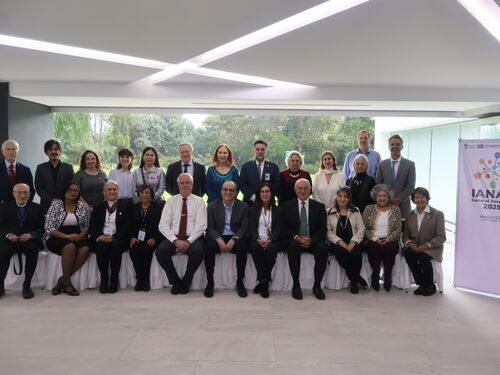Secretaries of Energy and Transportation Discuss Getting to ‘Net-Zero’ in U.S. Transportation During TRB’s 2023 Annual Meeting
Feature Story
By Josh Blatt
Last update January, 12 2023
U.S. Department of Energy Secretary Jennifer M. Granholm and U.S. Department of Transportation Secretary Pete Buttigieg took the stage yesterday at the 2023 annual meeting of the Transportation Research Board of the National Academies to discuss the federal government’s plan to reach “net-zero” carbon emissions in the U.S. transportation sector by 2050. TRB’s annual meeting is one of the largest global gatherings of transportation leaders, policymakers, and researchers.
During their “fireside chat” with TRB Executive Committee Chair Nathaniel P. Ford Sr. and Vice Chair Shawn Wilson, the two secretaries largely focused on a recently released national public-private sector blueprint for transportation decarbonization developed by DOE, DOT, and other federal agencies. “This blueprint allows for cooperation across government, which is really important,” said Granholm. “But it also involves so much partnership with folks across the country.”
A big focus of that plan includes equitably improving mobility and building out a nationwide network of electric vehicle (EV) chargers, zero-emission fueling infrastructure, and zero-emission transit and school buses, among a host of other initiatives.
“We all know the image of electric vehicle drivers sipping the latte in the big city on your way to get sushi — or whatever people imagine about electric vehicles,” said Buttigieg. “But if you think about it, in rural areas, you have longer distances [to drive], which means better potential gas savings. And you have more people living in single family homes, which means the opportunity to charge at home. So, we really need to continue to have a strategy that fits all of these different geographies, meets them where they are, and makes the possibilities clear.” In addition, the government is also fixed on building U.S. manufacturing and industrial capacity, driving down the cost of batteries, and providing tax credits for consumers purchasing new and used EVs.
Climate change, natural disasters, and other adverse events have helped expose vulnerabilities to the nation’s electric grid, and concerns have been raised about the strain that EVs could add to the system. “Charging [an EV] does pull electricity, but it also provides an opportunity to provide resiliency to the grid, if you have bi-directional charging — providing energy to and taking energy from that battery,” said Granholm. Bi-directional charging technology allows EVs to serve as “virtual power plants,” pushing energy back onto the grid at times with high demand or during disruptions.
Of course, decarbonizing transportation will involve much more than building EV capacity and infrastructure, said Buttigieg. Investments in public transportation, for example, are also critical. “[The administration’s] infrastructure vision contains the biggest investment in public transit, at the federal level, in the history of U.S. transportation. Even if we weren’t aggressively working to decarbonize existing modes of transportation, that alone, I think, is one of the biggest and best things we can do from a climate perspective,” he said.
Buttigieg also briefly addressed the news of the day ― the Federal Aviation Administration’s safety system outage, which led to a temporary shutdown of U.S. flights and travel delays for millions. Buttigieg said DOT is “now pivoting to focus on understanding the causes of the issue,” stating that “the main thing I want everybody to understand is that every step of the way, safety is going to be our north star, as it always is.”



